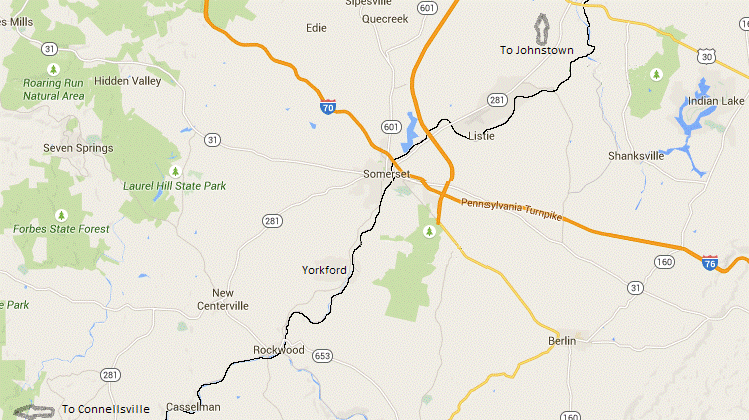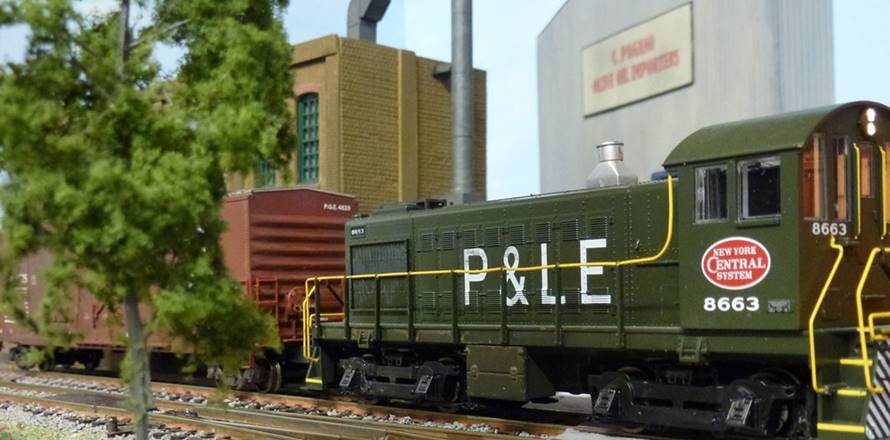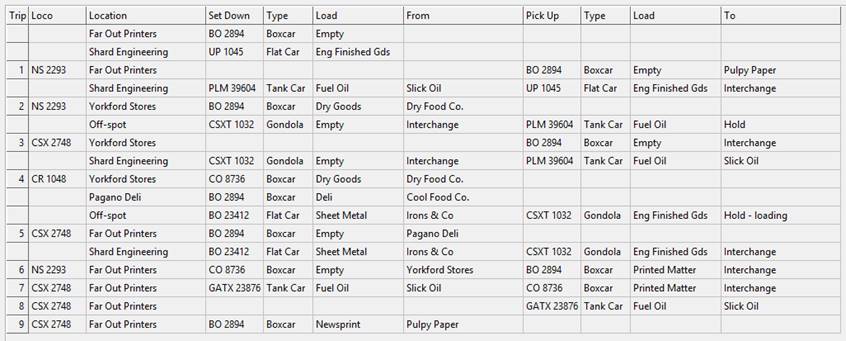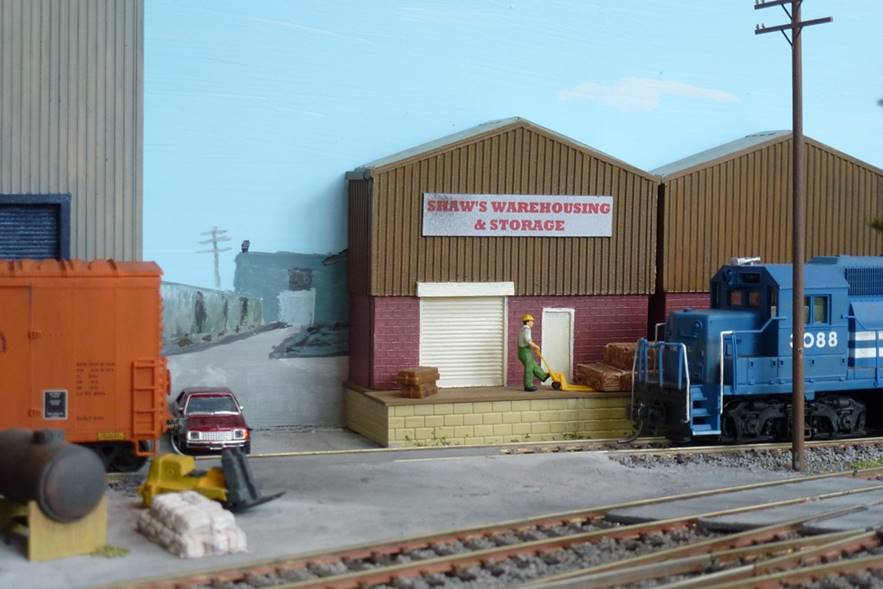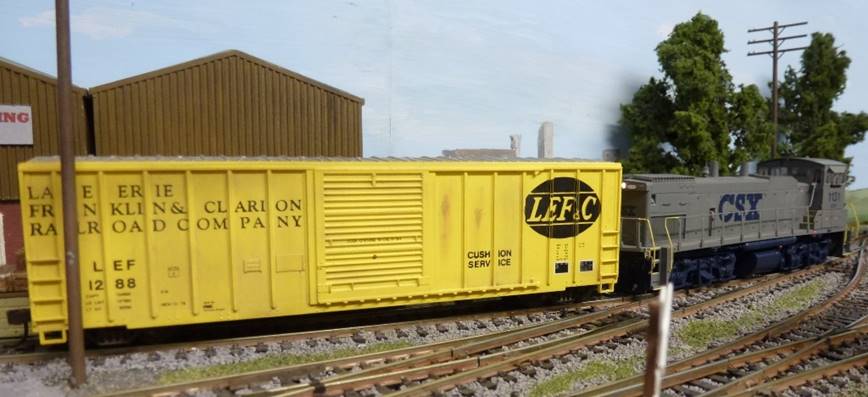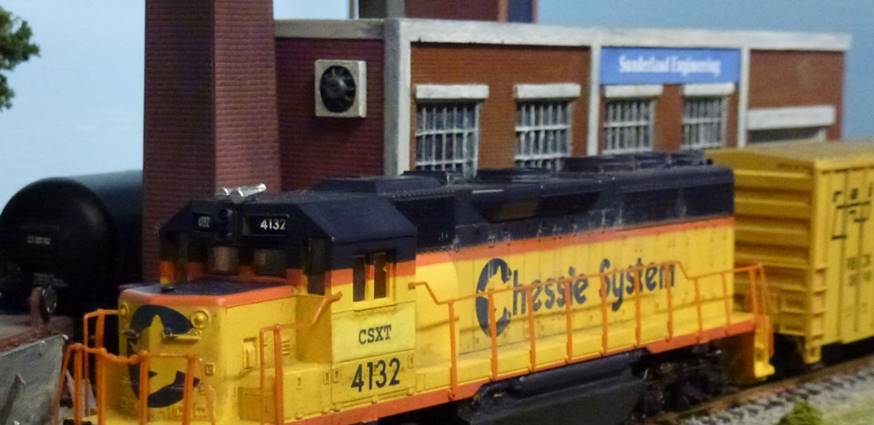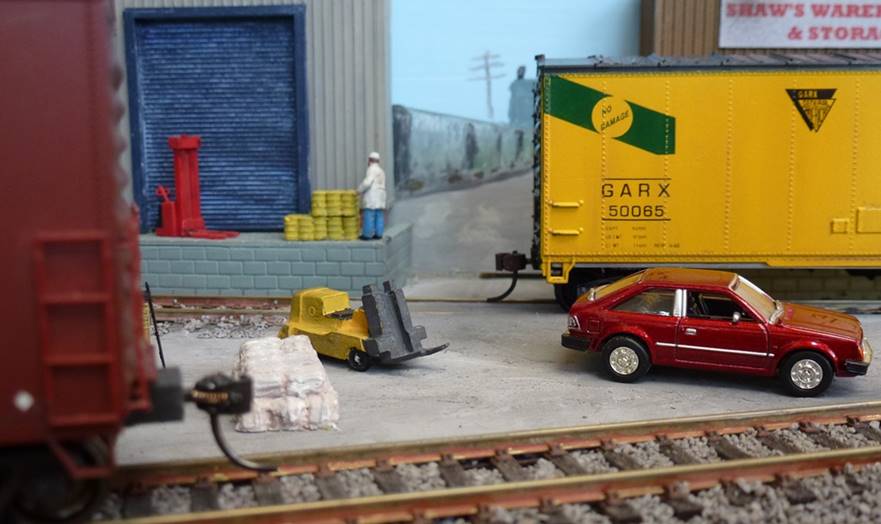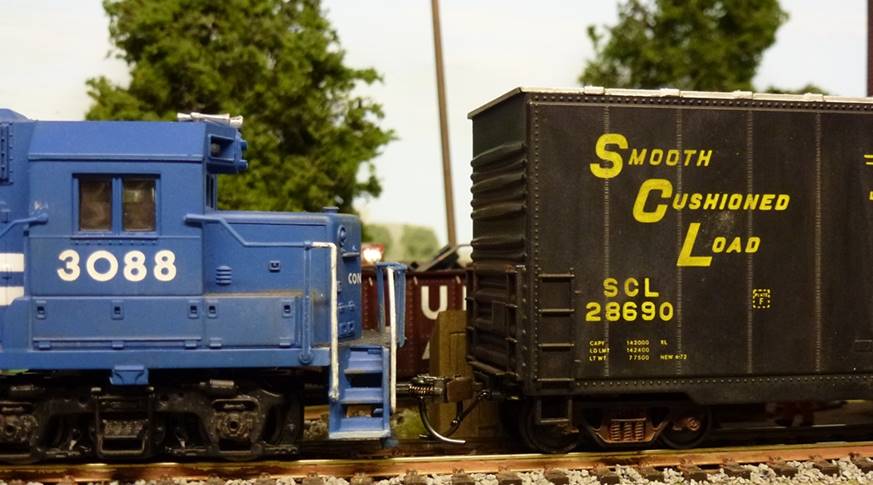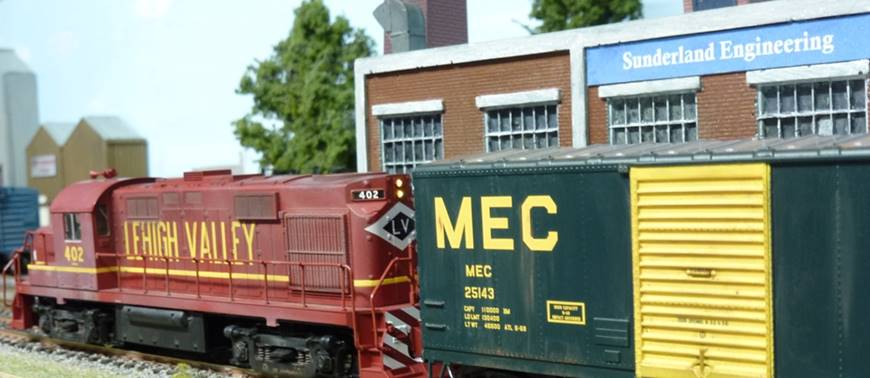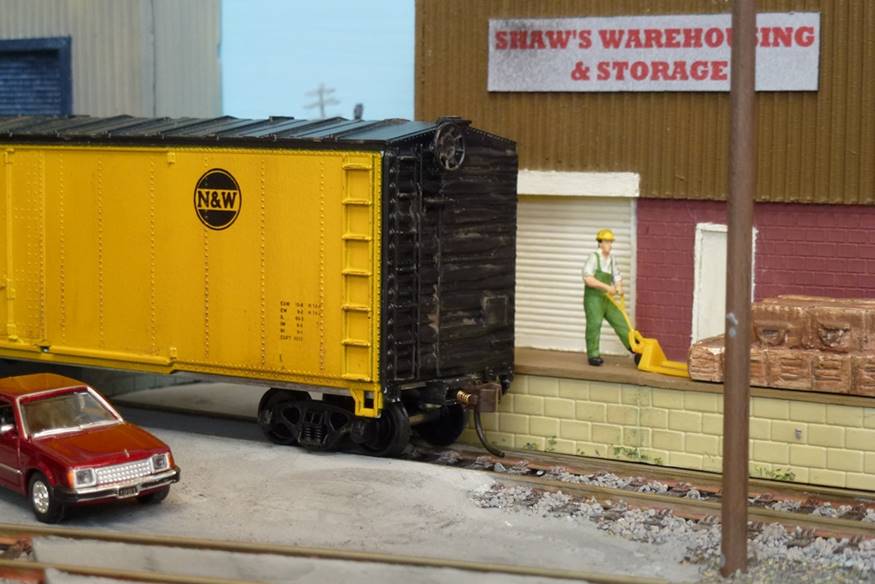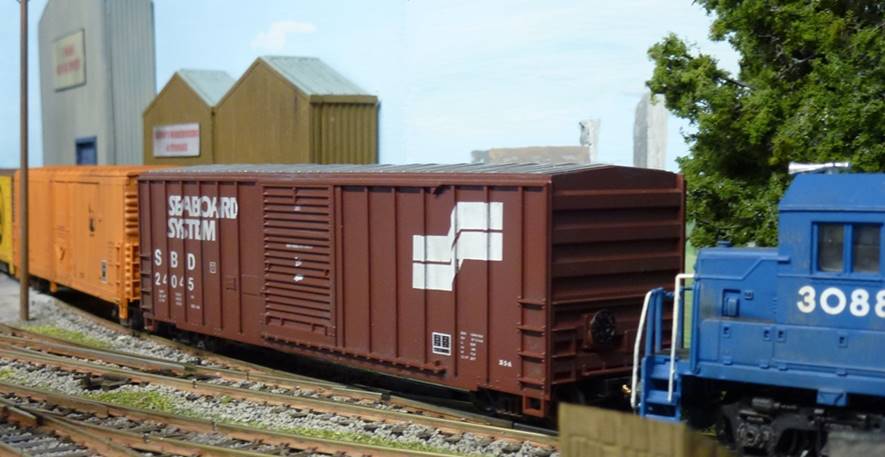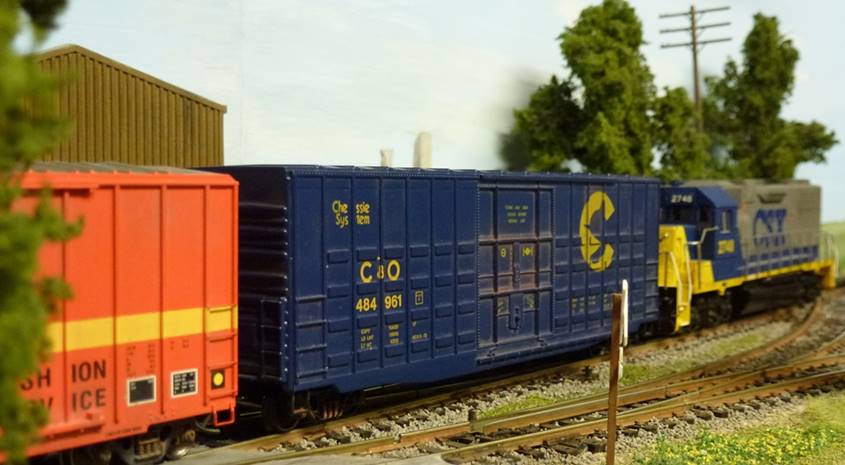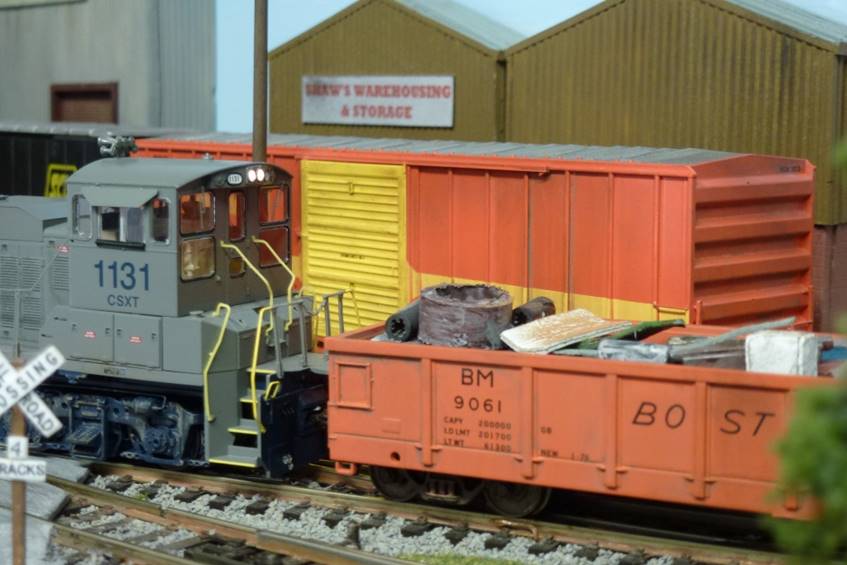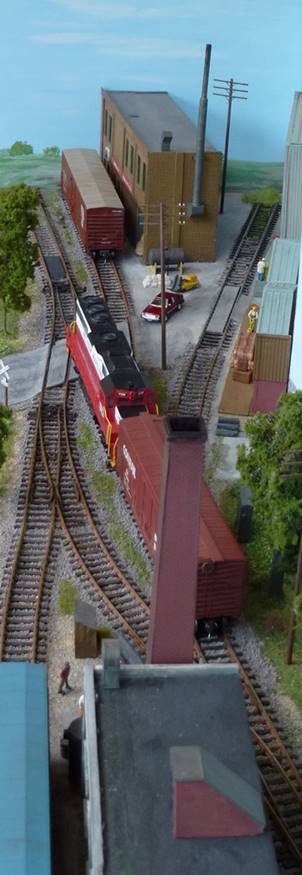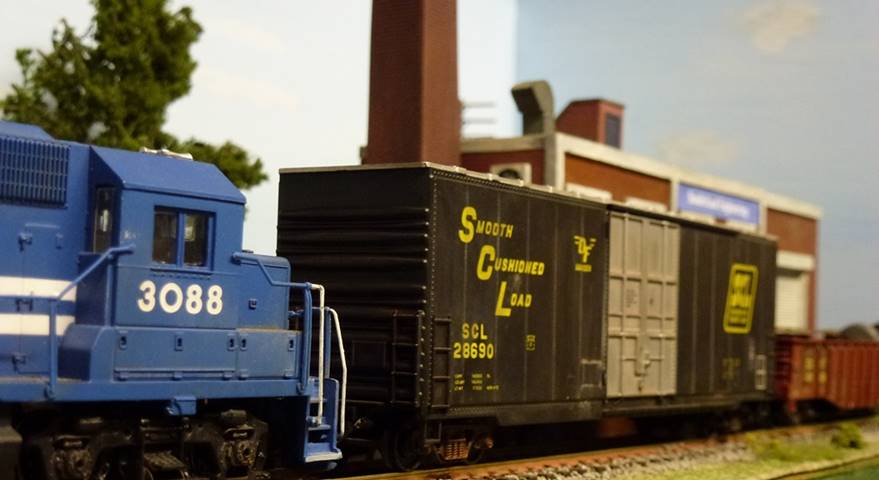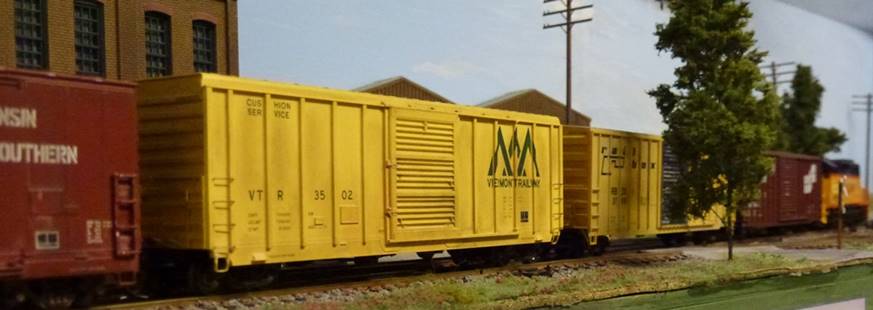Yorkford, PA
An industrial scene set in the USA

|
The SettingMy first attempt at American railroad modelling represents a small industrial complex on the outskirts of Yorkford, a fictional city in Pennsylvania. It was inspired by a small N gauge layout, Bart, by Norman Raven, which appeared in Continental Modeller in 2002. The layout looked like fun, and featured a smoking chimney and a flash welder that could be operated by spectators. Not being particularly drawn to N gauge, however, I decided to attempt something similar in the larger HO scale.
Two
busy scenes with switching in
full swing There
are many cities in northeast USA
with British namesakes: in
Pennsylvania, for example, York,
Bradford, Lancaster, Manchester
and Northampton can all be
found. York and Bradford both
have railroads and various types
of industry, including a
Harley-Davidson factory at York
and Zippo lighters at Bradford.
I have never visited either (or
anywhere else in the US, for
that matter), but as I live in
York, UK and was born in nearby
Bradford, cities both with a
rich railway history, the layout
almost named itself.
|
||||||||||||||||||
|
A
tank car outside Wilkinson
Printers awaits pickup.
Meanwhile, is that olive oil
company just a front? York and Bradford are both served by Class III (shortline) railroads. York has the York Railway, which operates the former Maryland & Pennsylvania Railroad, and Bradford is served by the Buffalo and Pittsburgh Railroad. Both are owned by Genesee & Wyoming Inc. and have identical paint schemes. So it would have been nice to reproduce something like this combination on Yorkford. In practice, though, finding models of shortline locomotives and stock is difficult, and as my painting skills would most likely ruin a model, I’ve stuck to Class I locomotives which are more or less suitable for the area and periods modelled. Interlopers from such as Southern Pacific and Burlington Northern appear sometimes, just like they do on the prototype.
A
grubby CP Rail Alco RS-3
nudges an equally unkempt
“modernised” 40ft boxcar
through the run-round loop.
Southern
high-nose GP50 7078 switches
the spur at Wilkinson
Printers. We have time-warped
into the 1980s. Seasoned
operators advise us to
pinpoint our layout location
on a map, so in my fiction,
Yorkford is located on Coxes
Creek between Somerset and
Rockwood in southwestern
Pennsylvania, in the Conrail
era between 1976 and 1999. The
line used to be the Somerset
& Cambria, and is now a
subdivision of Class I giant
CSX.
|
||||||||||||||||||
Track Plan and OperationThe scenic part of the layout measures four feet by one foot, with an extra four inches of track added on as an afterthought at the far left to enable two-car deliveries to Sunderland Engineering. The track design is necessarily simple, but even then it took me three attempts, with the track pinned into place for easy removal, before I was happy with it. |
||||||||||||||||||
|
Track
plan courtesy of Continental
Modeller
A
scrap gondola with another
“modernised” 40ft boxcar, this
time a hi-cube, without
roofwalk and with short ladder
and low brakewheel. The layout can be operated from the front or back, the points being changed by under-baseboard wooden dowels which run right through.
CSXT
1131 in “stealth” colour
scheme noses a hi-cube into
the run-round spur. For uncoupling, I placed a Kadee magnet between the rails on each run-round spur. However, I found delayed uncoupling using the magnets somewhat unreliable and now use a skewer instead.
Western
Maryland GP40 no. 3796 backs a
car alongside Pagano Olive
Oil. This loco was repainted in Chessie colours in the mid-1980s. There are four industries, all located off the central run-round loop, plus a team track. |
||||||||||||||||||
|
||||||||||||||||||
|
Action
on the team track as WM 3796
arrives to pick up a
hi-cube.
EraThe locos and stock are mostly suited to the late 1970s or early 1980s, but some belong to later periods. After starting off with pretty random purchases based on very little research, I started to rationalise as my knowledge increased. I now know that 40ft boxcars had been more or less phased out by 1980, as had roofwalks. During the 1960s and 1970s some boxcars were “modernised”, to meet new safety standards, by having their roofwalks removed and their brakewheels and ladders lowered. I ended up focusing on the post-roofwalk era, to the extent that now I can’t stand the things. The stencilled markings on the sides of freight cars can also indicate the era the cars belonged to, date of manufacture or reweigh date being an obvious giveaway of the earliest date a car was operational. I realised that some of the manufacture or reweigh dates on my freight cars were a bit early so I patched them. But that’s as fussy as I got. The vast majority of spectators at a typical exhibition just like to see trains moving in a believable setting. So, although I like to know what fits an era and location, getting things just right is, for me, largely a theoretical exercise.
Having
delivered a newsprint car to
Wilkinson Printers, Pittsburgh
& Lake Erie Alco S4 no.
8663 starts to back away. The
P&LE operated until 1993,
but this loco had been
repainted in Penn Central
colours by the mid-1970s. SwitchingSwitching a small layout can be a pretty tight affair, especially if you try and obey prototype rules – for example, keep the grade crossing free wherever possible, and ensure that a tank car carrying flammable liquid has a buffer car between itself and the loco. The fun increases when the team track is occupied; as this doubles as a spur for the run-round loop, any car on it usually has to be moved into the loop to be out of the way, and returned later. Add in the occasional caboose getting parked on the tracks, and things can get nicely clogged up. For a bit of switching variety, I have written a switching program to generate switching moves. These can be printed in switchlist format or in a simple car card/waybill style. Freight cars, loads carried and locations to be switched are all user-specified, as is the relative frequency with which each location is visited. There is a random element to the order and frequency of the switching moves. Instructions will be installed with the application but can also be downloaded separately.
Even with just a handful of industries and a few spots to make at each one, it’s surprising how much variety can be generated by introducing a random element to the switching order. It’s very seldom that the same overall position is repeated. |
||||||||||||||||||
|
|
||||||||||||||||||
|
Track and points are Peco code 100. The points are insulfrog, on “loan” from my father; I’d been wary of using these and probably wouldn’t have bought them myself, having been used to electrofrog on previous layouts, but as I don’t intend to get any short wheelbase locomotives I don’t envisage having a problem with electrical contact. I have, however, bonded the switchblades to their stock rails, having had a couple of problems with electrical continuity when relying just on contact from the switchblade tips. Bonding the switchblades was an afterthought, but I managed it without removing the points.
A
local trader has parked up his
Dodge pickup while he talks
business at Shaw’s Warehousing
& Storage. Another problem which surfaced was occasional short circuits caused by the wheels of one locomotive touching both turnout frog rails at the same time, just beyond the plastic dead section. With insulfrog turnouts, these rails are at opposite polarity. My solution was to apply a dab of black paint to each rail to effectively continue the dead section.
|
||||||||||||||||||
|
A
boxcar from the nearby
LEF&C, a shortline which
lasted into the 1990s, makes
an appearance. Electrics
are simple – one track feed at
either end of the run-round
loop, each “half” of the layout
being isolated from the other
with insulating rail joiners. The electrical feeds are soldered to the undersides of fishplates. This method is said to be unreliable, but I have used it before, with no ill effects if the fishplates are a tight fit. It’s neat and it avoids melting sleepers when soldering wire to the rails!
|
||||||||||||||||||
|
|
||||||||||||||||||
|
CSX
GP38-2 no. 2748 in Bright
Future paint scheme picks up
an empty newsprint car from
Wilkinson Printers.
Chessie
B&O 4132, now a patched
CSX loco, spots a RailBox
boxcar at Sunderland
Engineering to pick up a
consignment of new hand tools.
On the other side, the loco
still retains its original
B&O marking, so I can run
it in an earlier period. I hadn’t intended to ballast the track; it’s a job I hate doing, so I laid it onto ballast mat. But when everything was finished and I’d taken some photos, it didn’t look right. So my last job on the layout was one which should have been done almost at the start. I think I got away with it.
Franco
Pagano checks his new olive
oil shipment while a boxcar
half blocks the road. Locomotives and StockThe stock is nearly all second hand from online sources or model shows. It is all weathered to some degree and I have removed, or not fitted, all the boxcar roofwalks which were not moulded on. Bearing in mind that freight cars move all over the country, and that up to 50 percent of them could be from ‘foreign’ companies, with a bit of patching I have ended up with a mix that I think is more or less right for the location and decades modelled. The main oddity is probably that every freight car is different – an unlikely scenario.
All locomotives and stock run superbly well. In fact, a couple of the freight cars ran so freely that I installed braking mechanisms, in the form of plastic strips rubbing against the axles, to stop them moving on what to me and the spirit level are almost imperceptible gradients.
A
growly Alco RS-36 arrives to
pick up an empty from
Sunderland Engineering.
Norfolk
Southern SW1500 no. 2293 has
to run around that load of
sheet metal before it can
deliver off-scene to the
right. Most of the locos are from Bachmann, the exception being the Athearn MP15AC. Three locos are factory fitted with Tsunami sound decoders. I have fitted non-sound decoders into the rest, the sound for these being produced by two under-baseboard MRC diesel sounders, one at each end of the layout. These decoders provide a choice of six US diesel types, and are a very cost effective way of achieving decent quality sound.
Come
to pick up the boyfriend after
his shift at the
warehouse…while someone has
dumped an old car body hoping
the railroad will carry it
off. Most freight cars have been fitted with Kadee #5s or #148s. In some cases this involved removing old hornhook couplers, some of which had to be cut off from the trucks. |
||||||||||||||||||
Fiddle Yard |
||||||||||||||||||
|
|
||||||||||||||||||
|
As well as doing without ballasting I had intended to manage without a fiddle yard, but operation proved too restrictive without one, and the layout would have been little more than a diorama. A single track suffices, with room either side for stock storage. Buildings, Scenery, Smoke and Lighting
Joe
Rust and Eric Spigot
contemplate what to do with
the scrap outside Sunderland
Engineering. The gondola
behind seems pretty full. |
||||||||||||||||||
|
The backscene is foamboard braced with balsa wood strip. It is hand-painted with poster paint. |
||||||||||||||||||
|
The industries are represented by low relief resin, plastic and plaster kits from Unit Models, Walthers and Ten Commandments, with extra bought or scratch-built components added to provide detail or add depth. They were brush-painted with acrylics and enamels, and lightly weathered with powdered pastels. The industry names are all family-related.
|
||||||||||||||||||
|
Trees are from Woodland Scenics, with other scenic items and figures from various suppliers. I particularly like the two automobiles, purchased from Model Junction Online. They are cheap and I think they look rather good in their unweathered states.
|
||||||||||||||||||
|
I based the rail bumpers on a prototype photo, having been reliably informed that this type was more widely used on shortline railroads than the Hayes type. Mine are made from matchsticks, slightly pared to fit in between the sleepers. Some of the other scenic items, such as the oil tanks, cable reels and car loads, are also scratch-built. |
||||||||||||||||||
|
|
||||||||||||||||||
|
Charley
Pallet does a bit of light
lifting at Shaw’s Warehousing
& Storage. That N&W
boxcar has had its roofwalk
removed following regulations
but they haven’t bothered to
lower the brakewheel.
Another
scene from the 1970s showing
some 40ft boxcars with their
roofwalks removed.
Conrail GP40 no. 3088 has an SBD boxcar of goodies for Pagano but has to pull those other two cars out of the way first. I just had to make that chimney smoke, in the style of Bart, and this is achieved by a Seuthe 117 smoke unit inside the top of the chimney, connected to the DCC track output and controlled by a separately powered timer so that spectators can work it for a couple of minutes at a time by pushing a button.
|
||||||||||||||||||
|
The layout can feature ambient sound effects played by an MP3 player docked to its own small speaker system under the baseboard. The sounds were recorded from various YouTube train videos and mixed using the excellent free Audacity program. At exhibitions, the layout is lit by a warm white LED strip attached to an overhead pelmet on legs.
Prototype NotesAlco S4 P&LE 8663 possibly didn’t exist in the green paint scheme as sold by Bachmann and shown in the pictures. In any case it was re-painted Penn Central 9763 by 1976. The Pittsburgh & Lake Erie Railroad itself existed until 1992 when it was swallowed by CSX. Alco RS-3 CP 8438 was one of a batch bought new by Canadian Pacific in the 1950s. Many of them, in the red paint scheme and with the ‘multimark’ logo like the Bachmann model, saw operation in the northeast US in the 1970s. Alco RS-11 LV 402 was purchased new by the Lehigh Valley. In model form, Atlas have apparently represented is as the very similar RS-36. EMD SW1500 NS 2293 was ex-Illinois Terminal 1512. It was repainted from the ITC light blue and green in the mid-1980s. EMD GP40 WM 3796 was changed from Western Maryland to Chessie colours by CSX in 1983 or 1984 and patched to WM 6571. It was still in Chessie colours in 2008. I didn’t find any photos of it running in Pennsylvania, in its WM or Chessie paint schemes. EMD GP40 CR 3088 was an ex-New York Central and Penn Central loco. In the 1990s, after its Conrail days, it became successively Kyle RR 3108, Helm (HLCX) 3108, Amtrak 651 and Helm 651 then 4406. EMD GP40 BO (Chessie) 4132 was renumbered CSX 6032 by 1990 and repainted in CSX colours by 2004. I have patched it to CSXT on one side, so it can run in either the pre- or post-CSX periods, but I haven’t changed the number. EMD GP38-2 CSX 2748 is ex-Conrail 8130. It was repainted in the CSX YN2 ‘Bright Future’ scheme shown in the photos in the 2000s, though CSX started this paint scheme in 1990. EMD GP50 Southern 7078 would probably have been repainted to the similar Norfolk Southern scheme by 1990. GP50s were built from 1980. EMD MP15AC CSXT 1131 is ex-SBD 4226 and L&N 4226. The model is in the CSX “stealth” paint scheme of the late 1980s.
I
guess I’ll just have to block
the road while someone changes
those turnouts… |
||||||||||||||||||
|
…and
two views along almost the
whole length of the layout. Rod Shaw, 2017
Other layouts: |






